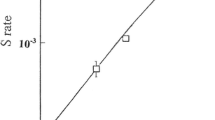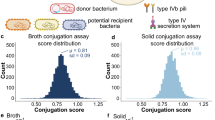Summary
R factors of the N incompatibility group apparently transfer at low frequencies (often 10-6–10-5 per donor cell) in 30 min liquid matings. However, the level of transfer is greatly increased when donor-recipient mixtures are held on solid medium selective for the recipient only, prior to transconjugant selection. Increase in transconjugant recovery is still donor-dependent at plating and therefore arises from mating on the plate. The process limiting N-mediated conjugation in liquid is probably mating pair formation, suggesting that the increase in yield of transconjugants may result from provision of a solid substrate for mating pair formation rather than from the delay in selection per se. The kinetics of N plasmid transfer on solid medium resemble those of transfer of a derepressed, rather than a repressed, F-like R factor. Preliminary experiments suggest that RP4, the prototype P incompatibility group plasmid, shows a stimulation of transfer on solid medium similar to the N plasmids studied.
We suggest that N, and probably P, plasmids are (like F and the col V's) naturally derepressed for fertility, but this is masked by the incompetence in liquid matings of donors carrying them.
Similar content being viewed by others
References
Bradley, D. E.: Adsorption of bacteriophages specific for Pseudomonas aeruginosa R factors RP1 and R1822. Biochem. biophys. Res. Commun. 57, 893–900 (1974)
Brinton, C. C., Jr.: The properties of sex pili, the viral nature of “conjugal” genetic transfer systems, and some possible approaches to the control of bacterial drug resistance. Crit. Rev. Microbiol. 1, 105–160 (1971)
Brodt, P., Leggett, F., Iyer, R.: Absence of a pilus receptor for filamentous phage IKe. Nature (Lond.) 249, 856–858 (1974)
Clowes, R. C., Hayes, W.: Experiments in mircorbial genetics. Oxford: Blackwell Scientific Publications, 1968
Datta, N., Lawn, A. M., Meynell, E.: The relationship of F type piliation and F phage sensitivity to drug resistance transfer in R+F- Escherichia coli K12. J. gen. Microbiol. 45, 365–376 (1966)
Datta, N., Hedges, R. W.: Compatibility groups among fi- R factors. Nature (Lond.) 234, 222–223 (1971)
Datta, N., Hedges, R. W., Shaw, E. J., Sykes, R. B., Richmond, M. H.: Properties of an R factor from Pseudomonas aeruginosa. J. Bact. 108, 1244–1249 (1971)
Dennison, S.: Naturally occurring R factor, derepressed for pilus synthesis, belonging to the same compatibility group as the sex factor F of Escherichia coli K12. J. Bact. 109, 416–422 (1972)
Dennison, S.: Control of fertility of resistance transfer factors in Proteus mirabilis and related bacterial species. Ph. D. Thesis, University of Leeds (1973)
Dennison, S., Baumberg, S.: N plasmid transfer in Escherichia coli and adsorption of the N-specific filamentous phage IKe. Proc. Soc. gen. Microbiol. 1, 10 (1973)
Falkow, S., Wohlhieter, J. A., Citarella, R. V., Baron, L. S.: Transfer of episomic elements to Proteus. I. Transfer of F-liked chromosomal determinants. J. Bact. 87, 209–219 (1964)
Grindley, N. D., Humphreys, G. O., Anderson, E. S.: Molecular studies of R factor compatibility groups. J. Bact. 115, 387–398 (1973)
Hedges, R. W.: Phenotypic characterization of fi- R factors determining the restriction and modification hspII specificity. Molec. gen. Genet. 115, 225–233 (1972)
Hedges, R. W.: R factors from Providence. J. gen. Microbiol. 81, 171–181 (1974)
Ingram, L. C.: Deoxyribonucleic acid hybridisation of R factors. J. Bact. 115, 1130–1134 (1973)
Khatoon, H., Iyer, R. V., Iyer, V. N.: A new filamentous bacteriophage with sex factor specificity. Virology 48, 145–155 (1972)
Lawn, A. M., Meynell, E.: Serotypes of sex pili. J. Hyg. (Camb.) 68, 683–694 (1970)
Meynell, E., Cooke, M.: Repressor-minus and operator-constitutive derepressed mutants of F-like R factors: their effect on chromosomal transfer by HfrC. Genet. Res. (Camb.) 14, 309–313 (1969)
Meynell, E., Datta, N.: The relation of resistance transfer factors to the F factor of Escherichia coli K12. Genet. Res. (Camb.) 7, 134–140 (1966)
Nisioka, T., Mitani, M., Clowes, R. C.: Composite circular forms of R factor deoxyribonucleic acid molecules. J. Bact. 97, 376–385 (1969)
Novotny, C. P., Fives-Taylor, P.: Retraction of F pili. J. Bact. 117, 1306–1311 (1974)
Olsen, R. H., Shipley, P.: Host range and properties of the Pseudomonas aeruginosa R factor R1822. J. Bact. 113, 772–780 (1973)
Pühler, A., Burkardt, H. J., Heumann, W.: Genetic experiments with the Pseudomonas aeruginosa R factor RP4 in Rhizobium lupini. J. gen. Microbiol. 73 xxvi (1972)
Smith, H. W., Lingood, M. A.: Transfer factors in Escherichia coli with particular regard to their incidence in enteropathogenic strains. J. gen. Microbiol. 62, 287–299 (1970)
Author information
Authors and Affiliations
Additional information
Communicated by W. Maas
Rights and permissions
About this article
Cite this article
Dennison, S., Baumberg, S. Conjugational behaviour of N plasmids in Escherichia coli K12. Molec. Gen. Genet. 138, 323–331 (1975). https://doi.org/10.1007/BF00264802
Received:
Issue Date:
DOI: https://doi.org/10.1007/BF00264802




